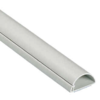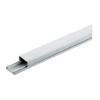Hello, so basically we have some floating alcove shelves. We'd like to get some power up to them for some lights, and maybe even stick a mesh wifi router up on one but main thing we want to do is to get some kind of lighting up there and we don't want visible cables running up the wall. I'm a bit confused as to what is and isn't allowed.. so for example, is it OK to just channel out the wall (which is brick), stick in a plastic conduit, plaster it over and have an extension cable going up that and sitting on a shelf? I think if it's removable it's OK to do this? It would be about 2m of extension cable. If it's not a good idea to do this, if I still had a conduit can I put some LED lights up there, ie. usb powered ones and just feed them down, or would that also be a no-no? Or would it be best to just bite the bullet and have proper plug sockets put into the walls at the respective shelf heights?
Cheers!
Cheers!





